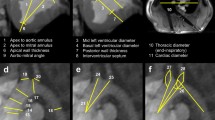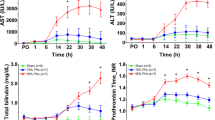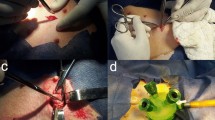Abstract
A primary limitation in hepatic surgery is leaving a remnant liver of adequate size and function. Experimental models have been designed to study processes of liver injury and regeneration in this context, yet a formula to accurately calculate liver mass in an animal model is lacking. This study aims to create a novel and simple formula to estimate the mass of the native liver in a species of pigs commonly used in experimental liver surgery protocols. Using data from 200 male weanling Landrace-Large White hybrid pigs, multiple linear regression analysis is used to generate the formula. Clinical features used as variables for the predictive model are body mass and length. The final formula for pig liver mass is as follows: Liver mass (g) = 26.34232 * Body mass (kg) – 1.270629 * Length (cm) + 163.0076; R2 = 0.7307. This formula for porcine liver mass is simple to use and may be helpful in studies using animals of similar characteristics to evaluate restoration of liver mass following major hepatectomy.
Similar content being viewed by others
Introduction
In recent decades, the application of liver resection has expanded in its indication and application. However, a primary limiting factor for performing major liver resection in the clinical setting remains the need to leave a liver remnant of adequate size, quality, and function, in order to avoid the development of post-hepatectomy liver failure (PHLF)/“small-for-size” syndrome (SFSS) in the postoperative period. PHLF/SFSS is characterized by progressive cholestasis, coagulopathy, encephalopathy, ascites, gastrointestinal bleeding, and/or renal failure. Once PHLF/SFSS is diagnosed, it is associated with high patient morbidity and mortality1,2.
While the pathophysiology of PHLF/SFSS is multifactorial, the size of the remnant liver is a critical factor in its development. Depending on the conditions of the patient and the liver itself, more or less remnant liver mass is needed to avoid PHLF/SFSS. Typically, it is recommended that the ratio between the remnant liver and recipient body mass be >0.8–1% and the remnant represent >25–30% of native liver mass for normal livers or >40% in livers that are cholestatic, cirrhotic, steatotic, or injured by chemotherapy3,4. Therefore, to be able to adequately evaluate the remnant liver mass preoperatively, is of great interest.
Different animal models have been developed to study liver resections. Our research group has worked extensively in experimental models of orthotopic liver transplantation in pigs5,6,7,8,9,10,11. Pigs were selected because they present similar liver size, anatomy, and physiology to that of humans. We have also developed a porcine model of extended liver resection, in which we evaluate postoperative liver function, regeneration, and survival. In the latter model, we analyze the impact of the remnant liver mass on recovery and regeneration following major hepatectomy. While we can know the mass of the liver that is resected, we cannot easily know the true mass of the liver that is left behind. Therefore, the aim of the present study is to create a formula to estimate total liver mass using data from our previous experience with total hepatectomies performed in the context of porcine liver transplantation.
Patients and Methods
Animals
Since 2005, our group has performed total hepatectomy in over 200 weanling (2–4 months) male Landrace-Large White hybrid pigs5,6,7,8,9,10,11. Animals included in this study were from the same provider, underwent through equal transportation, had the same access to and type of food as to water, and were subjected to the same environmental acclimation and perioperative care. As well, all animals had a certificate of good health signed by the animal provider.
Procedures were conducted in the Animal Experimentation Unit at the University of Barcelona Medical School and in accordance with current national and European regulations. The Animal Experimentation Unit is authorized by the Catalan Department of Agriculture, Husbandry, and Fisheries (authorization number B9900020), registered in the General Registry of Livestock Facilities (ES080190036536), and accredited by the International Standards Organization (ISO 9001:2015). Animals were cared for according to the guidelines of the University of Barcelona Committee on Ethics in Animal Experimentation and the Catalan Department of the Environment Commission on Animal Experimentation.
Statistical analysis
Data from 200 pigs was used in this study. Using randomized split sample technique12,13, 142 pigs (70% of the overall sample) were included in the derivation group and 58 (30%) in the validation group. The following variables were evaluated in the derivation group: body mass (kg), snout-to-rump length (cm), and body surface area (m2). Variables associated with total liver mass on univariate analysis (P < 0.2) were selected for the initial models. Using the allsets tool, seven initial models were generated14,15. The final model was selected based on Mallows’ Cp and adjusted R2 values, as high adjusted R2 is essential for good predictive-model performance16. The selected model was then validated in the validation group. Differential loss (shrinkage value) <10% was deemed necessary to consider the model valid and reliable.
Results are presented as frequencies and percentages for categorical variables and median and interquartile range for continuous variables. For univariate analyses, Chi-square test was used for categorical variables, Student’s t test or ANOVA for normal continuous variables, and Mann-Whitney or Kruskal Wallis tests for non normally distributed continuous variables. In all statistical analyses, significance was set at P < 0.05. All data analysis was performed using STATA version 4.0 (StataCorp LLC, College Station, Texas, USA).
Ethical approval
This study received ethical approval by the University of Barcelona Committee on Ethics in Animal Experimentation and the Catalan Department of the Environment Commission on Animal Experimentation. All experiments were performed in accordance with current national and European regulations.
Results
The characteristics and features of both samples cohorts are described in Table 1. No significant differences between the two groups were detected.
On univariate analysis, body mass, snout-to-rump length, and BSA were all significantly associated with total liver mass. These three variables were introduced in the allsets tool to determine all possible equations for predicting porcine liver mass, and seven different models were identified. Ultimately, body mass and snot-to-rump length were selected as the final predictors. After performing multiple linear regression analysis, the final formula for pig liver mass (PLM, g) was generated: 26.34232 * Body mass (kg) – 1.270629 * Length (cm) + 163.0076; R2 = 0.7307 and adjusted R2 = 0.7268, Mallows’ Cp 10.28, variance inflation factor (VIF) 6.2 (Fig. 1). For the variables used, Fig. 2 depicts the individual correlations between both of the predictors and total liver mass.
The formula was validated in a split group consisting in 30% of the subjects in the original sample. Differential loss of prediction (shrinkage) was 5.56% (R2-r2Loss = 0.05645025). To further validate our model, we calculated the variance of the residuals of the multiple regression analysis and did not find any significant variation of residuals (Fig. 3).
Finally, using the new pig liver mass formula, we used the entire sample to compare true versus calculated liver mass (Table 2 & Fig. 4).
Discussion
In liver surgery, accurate calculation of remnant liver size is critically important to reducing postoperative morbidity and mortality, in particular due to PHLF/SFSS17. To this end, several formulae have been developed to estimate liver mass or volume in humans preoperatively18,19. Such formulae typically include clinical features, such as body mass, height, and/or body surface area (BSA)20. The formula proposed by Kokudo et al. uses more specific morphological features, namely thoracic and abdominal width21. All of these formulae have been created by comparing estimated size with either volumetric calculation obtained through computed tomography (CT) scanning or real liver mass obtained in the context of whole or partial liver transplantation. The overall accuracy and applicability of the aforementioned formulae may be limited to a certain extent by patient gender, age, and race. Also, BSA may be calculated in different manners, and formulae that include BSA as an input variable may vary accordingly.
While several formulae are available for liver size prediction in humans, little is available for studies in animals. Experimental models are of critical importance for surgical investigation, as they offer the opportunity to test novel techniques and therapies under relatively stable conditions prior to their application in humans. Animal studies on liver regeneration are particularly relevant in that they can help elucidate mechanisms of liver regeneration in vivo and can be used in the extreme to simulate and attempt to prevent and/or treat pathological regenerative processes22.
Until now, assessment of total and remnant liver size in porcine liver resection studies has generally required the use of advanced imaging techniques, such as CT or magnetic resonance imaging23. Bekheit et al. recently published an assessment of porcine liver anatomy in which volumetric characteristics as well as features of the vascular and biliary trees were described using CT performed on 37 female pigs24. While cross-sectional imaging is relatively reliable, especially in clinical practice, it is costly and not always easily accessible for use in animals.
We wanted to create a formula for predicting porcine liver mass that was simple to use and that incorporated morphological variables that were easy to obtain. We chose not to include BSA, given that there is no universally accepted formula for calculating BSA nor, for that matter, one that has been validated for pigs. The formula that we have created, based on body mass and length, appears to estimate total liver mass well, with R2 = 0.73 and differential loss of prediction <10% (5.56%) on external validation. Nonetheless, the study does have limitations. Animals included in the study were all males of common European pig breeds (hybrid Landrace-Large White) and aged between two and four months. This formula needs to be tested in a wider variety of pigs of different ages, breeds, and sex to determine whether it remains accurate.
The pig is the most commonly selected large animal for performing pre-clinical studies on the liver. Pigs are robust and readily available; their livers present a similar size to those of humans and can also be divided into eight segments based on vascular supply and biliary drainage25. An important anatomical aspect of the porcine liver that distinguishes it from that of other species is its intimate relationship with the inferior vena cava (IVC). The porcine IVC is contained within and cannot be separated from the tissue of the caudate and right lateral lobes. As such, the minimum remnant volume after major hepatic resection is greater in pigs than in other species. Different authors have evaluated the percentage of overall liver mass that each liver segment represents, and the caudate and complete right lateral lobes appear to constitute roughly 30% of the entire porcine liver25,26,27. Using our formula, however, our hope is that future estimates of the remnant liver in major hepatectomy studies in pigs will be more accurate than those based on rough percentages.
In summary, we have created a novel formula to predict pig liver mass in a simple and reproducible manner. This formula should be a useful tool for future liver surgery studies performed in the porcine model.
Data Availability
The data generated and analyzed during this study are available from the corresponding author on reasonable request.
References
Imura, S., Shimada, M., Ikegami, T., Morine, Y. & Kanemura, H. Strategies for improving the outcomes of small-for-size grafts in adult-to-adult living-donor liver transplantation. J Hepatobiliary Pancreat Surg. 15, 102–110 (2008).
Truant, S. et al. Factors associated with fatal liver failure after extended hepatectomy. HPB. 19, 682–687 (2017).
Troisi, R. I., Berardi, G., Tomassini, F. & Sainz-Barriga, M. Graft inflow modulation in adult-to-adult living donor liver transplantation: A systematic review. Transplantation Rev. 31, 127–135 (2017).
Kurihara, T. et al. Graft selection strategy in adult-to-adult living donor liver transplantation: When both hemiliver grafts meet volumetric criteria. Liver Transpl. 22, 914–22 (2016).
Fondevila, C. et al. Portal hyperperfusion: mechanism of injury and stimulus for regeneration in porcine small-for-size transplantation. Liver Transpl. 16, 364–374 (2010).
Hessheimer, A. J. et al. Decompression of the portal bed and twice-baseline portal inflow are necessary for the functional recovery of a “small-for-size” graft. Ann Surg. 253, 1201–1210 (2011).
Hessheimer, A. J. et al. Somatostatin therapy protects porcine livers in small-for-size liver transplantation. Am J Transplant. 14, 1806–1816 (2014).
Fondevila, C. et al. Step-by-step guide for a simplified model of porcine orthotopic liver transplant. J Surg Res. 167, 39–45 (2011).
Fondevila, C. et al. Superior preservation of DCD livers with continuous normothermic perfusion. Ann Surg. 254, 1000–1007 (2011).
Fondevila, C. et al. Hypothermic oxygenated machine perfusion in porcine donation after circulatory determination of death liver transplant. Transplantation. 94, 22–29 (2012).
Hessheimer, A. J. et al. Heparin but not tissue plasminogen activator improves outcomes in donation after circulatory death liver transplantation in a porcine model. Liver Transpl. 24, 665–676 (2018).
Snee, R. D. Validation of regression models: methods and examples. Technometrics. 19, 415–428 (1977).
Stone, M. Cross-validatory choice and assessment of statistical predictions (with discussion). J R Stat Soc Series B Stat Methodol. 36, 11–148 (1974).
Doménech i Massons, J. M., Navarro, J. B. Regresión múltiple con predicadores categóricos y cuantitativos. (10th edition) 174–183 (ed. Barcelona: Signo, 2017).
Furnival, G. M. & Wilson, R. W. Jr. Regressions by leaps and bounds. Technometrics. 16, 499–511 (1974).
Mallows, C. L. Some comments on Cp. Technometrics. 15, 661–75 (1973).
Goldaracena, N., Echeverri, J. & Selzner, M. Small-for-size syndrome in live donor liver transplantation - Pathways of injury and therapeutic strategies. Clin Transplant. 31, 12885; 10.1111/ctr. (2017).
Yaprak, O. et al. Ratio of remnant to total liver volume or remnant to body weight: which one is more predictive on donor outcomes? HPB. 14, 476–482 (2012).
Yoshizumi, T. et al. A simple new formula to assess liver weight. Transplant Proc. 35, 1415–1420 (2003).
Urata, K. et al. Calculation of child and adult standard liver volume for liver transplantation. Hepatology. 21, 1317–1321 (1995).
Kokudo, T. et al. A new formula for calculating standard liver volume for living donor liver transplantation without using body weight. J Hepatol. 63, 848–854 (2015).
Palmes, D. & Spiegel, H. U. Animal models of liver regeneration. Biomaterials. 25, 1601–1611 (2004).
Asencio, J. M. et al. Preconditioning by portal vein embolization modulates hepatic hemodynamics and improves liver function in pigs with extended hepatectomy. Surgery. 161, 1489–1501 (2017).
Bekheit, M., Bucur, P. O., Wartenberg, M. & Vibert, E. Computerized tomography-based anatomic description of the porcine liver. J Surg Res. 210, 223–230 (2017).
Court, F. G. et al. Segmental nature of the porcine liver and its potential as a model for experimental partial hepatectomy. Br J Surg. 90, 440–444 (2003).
Court, F. G. et al. Subtotal hepatectomy: a porcine model for the study of liver regeneration. J Surg Res. 116, 181–186 (2004).
Kelly, D. M. et al. Porcine partial liver transplantation: a novel model of the “small-for-size” liver graft. Liver Transpl. 10, 253–263 (2004).
Author information
Authors and Affiliations
Contributions
L.M.M., conception of the work, analysis and interpretation of data, and drafting the work. V.P., analysis and interpretation of data and critical revision of the work for intellectual content. A.J.H., data acquisition and critical revision of the work for intellectual content. J.M., data acquisition and critical revision of the work for intellectual content. J.C.G.V., conception and critical revision of the work for intellectual content. C.F., conception and critical revision of the work for intellectual content. This work has been seen and approved by all the authors, and all the authors agree to be accountable for all aspects of the work.
Corresponding author
Ethics declarations
Competing Interests
Funding for the procedures performed in this study was provided by FIS (Fondo de Investigación Sanitaria) grants 04/1238, 05/0610, 08/0273, 11/01979, and 15/01092 from the Carlos III Institute of Health (Ministry of Health and Consumption) and FEDER funds. L.M.M. was supported in part by a grant from the Fundació Catalana de Trasplantament.
Additional information
Publisher’s note: Springer Nature remains neutral with regard to jurisdictional claims in published maps and institutional affiliations.
Rights and permissions
Open Access This article is licensed under a Creative Commons Attribution 4.0 International License, which permits use, sharing, adaptation, distribution and reproduction in any medium or format, as long as you give appropriate credit to the original author(s) and the source, provide a link to the Creative Commons license, and indicate if changes were made. The images or other third party material in this article are included in the article’s Creative Commons license, unless indicated otherwise in a credit line to the material. If material is not included in the article’s Creative Commons license and your intended use is not permitted by statutory regulation or exceeds the permitted use, you will need to obtain permission directly from the copyright holder. To view a copy of this license, visit http://creativecommons.org/licenses/by/4.0/.
About this article
Cite this article
Martínez de la Maza, L., Prado, V., Hessheimer, A.J. et al. A novel and simple formula to predict liver mass in porcine experimental models. Sci Rep 9, 12459 (2019). https://doi.org/10.1038/s41598-019-48781-2
Received:
Accepted:
Published:
DOI: https://doi.org/10.1038/s41598-019-48781-2
Comments
By submitting a comment you agree to abide by our Terms and Community Guidelines. If you find something abusive or that does not comply with our terms or guidelines please flag it as inappropriate.







